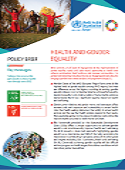SDG 5: Health and gender equality

Download
The framework provided by the Sustainable Development Goals (SDGs) offers a unique opportunity to achieve gender equality and simultaneously improve health and well-being for all. SDG5 highlights gender equality as a stand-alone goal but also recognizes progress on this SDG not only contributes to the others, but many SDGs cannot be achieved without progress on gender inequality.
- Member States of the WHO European Region have some of the highest levels of gender equality in the world, but there are differences across the Region.
- Gender inequality is not simply a matter of human rights; evidence demonstrates that it has a significant negative impact on health and well-being – whether through discrimination, violence, inadequate sexual and reproductive rights and health, unpaid care work, child marriage or genital mutilation.
- Gender power relations and gender norms and stereotypes affect women’s and men’s exposure and vulnerability to certain health risks, their health-seeking behaviour, their ability to access health services and the way that health systems respond to their needs.
- More equitable gender norms, roles and relations could profoundly improve health outcomes for both women and men.
- WHO commits at all levels of engagement, to the implementation of gender equality, equity and rights-based approaches to health that enhance participation, build resilience, and empower communities.
- In the WHO European Region, the Strategy on Women’s Health and Well-being and the Strategy on the Health and Well-being of Men strengthen the links between SDG 3 and SDG 5 and provide a comprehensive working framework for Member States.



